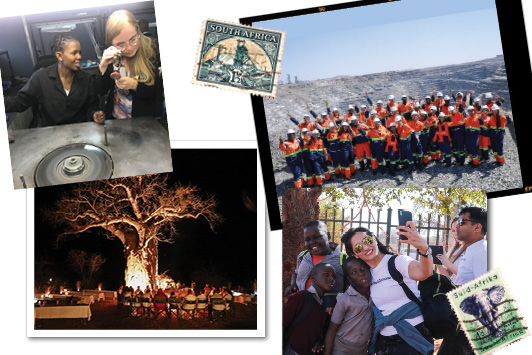
Anyone who wants to know how to transform a diamond business and safeguard its future might do well to speak to the 25 members of the Young Diamantaires group who went on a mission to South Africa earlier this year.
The delegates from 10 countries included a jeweler who’d set up a museum to boost interest in gems, another who had begun offering lab-grown diamonds, and several social-media buffs. This reporter was not the only participant who sat at the back of the bus receiving Instagram lessons from true millennials.
Young Diamantaires came into being in 2016, when Rami Baron, chairman of the promotions committee for the World Federation of Diamond Bourses (WFDB), saw the need to help the new generation of industry members connect. He set up a WhatsApp group — which attracted more than 250 members — and has organized meetings at trade shows. The oversubscribed visit to De Beers’ Venetia mine in September was the most ambitious plan yet, involving a day at the site, excursions to a local school and the nearby Mapungubwe National Park, and an opportunity to meet businesses De Beers supports in the surrounding area.
Beneath the surface
The strong consensus on the trip was that mining companies needed to grant this sort of access to people who were interested, and not just those with a direct commercial connection to the operations. De Beers has often welcomed clients at its mines (and once hosted reality star Kim Kardashian at the Jwaneng deposit in Botswana), but the members of the Young Diamantaires were in a different category. Many of them were looking to learn more about the industry and bring back knowledge they could use to help sell diamonds in their or their customers’ retail stores.
“People [once] wanted to be secretive about what goes on in a mine. But I have seen huge change in this,” says Prernaa Makharia, an India-based jewelry blogger and influencer, and one of the volunteer social-media tutors. “[Companies] have started believing in the concept of bringing awareness to consumers about what goes on behind the scenes.”
For instance, the group met mining workers who seemed happy in their jobs; encountered the stringent safety rules De Beers enforces at Venetia; and were able to ask mine managers about the operational details. Among other things, they learned about the current expansion from open-pit to underground mining, which will ensure rough supply through 2046.
De Beers also arranged a visit to one of the 19 local schools the company funds, and invited some nearby businesses — which De Beers also supports — to display their merchandise at the lodge where the group was staying. After all, modern consumers increasingly care about the social good associated with products and want real assurances about the provenance of diamonds.
“Where they do these things, other mining companies are bound to follow,” says Kealeboga Pule, founder and managing director of Johannesburg-based Nungu Diamonds, who initiated and helped organize the trip. “They’re realizing the need to be more open.”
Social responsibility
In addition to being informative, the three days were an opportunity to devise ways of helping people in South Africa while also boosting sales at home. One evening, after the group had visited the De Beers-sponsored Renaissance Secondary School in the northern town of Musina, Baron sat the group around a campfire to discuss how they could raise $140,000 to fund a library and cafeteria for the pupils.
Under a baobab, the region’s protected “upside-down” tree, they debated the details of how to find the money, but one thing kept coming up: Not only does the industry have an ethical imperative to get involved in these local projects, it has a commercial interest in sharing news of its efforts as a story for consumers. (One such narrative might center around the baobabs, which De Beers has worked to conserve by transplanting whenever mining operations force the company to uproot them.)
“[The campfire discussion] sparked a desire and determination to make a change and to contribute,” Baron says. “The highlights have been shared with [De Beers] executives, who could see the rawness of emotion we all experienced,” as well as that eagerness to effect change.
The participants’ visit to Mapungubwe, a hilltop located in a national park of the same name, yielded other stories, as the site has a rich jewelry history. In the 13th century, it was a trading hub for gold and ivory — a fact that gained attention in 1932, when a treasure chest full of artifacts was found there.
Millennial mind-set
To create export opportunities for cutters in South Africa, Young Diamantaires is now piloting a supply arrangement with Australia, where Baron is based. It also plans to expand the group through a website and, potentially, by launching global chapters, the founder adds.
In fact, the group has proven too successful for its social-media platform: Membership of Young Diamantaires recently exceeded WhatsApp’s 256-person limit, forcing it to restart on rival
app Telegram.
The participants know they have a difficult task reforming the wider industry. Attitudes in the trade are changing slowly, but there still needs to be a shift in the way people approach new ideas and younger trade members, they argue. Many older diamond dealers believe the current downturn is simply another dip that will end with an upturn, but this is incorrect, says Alain Zlayet, CEO and founder of Antwerp-based Zlayet & Sons Diamonds.
“We are the ones who are thinking and talking and researching in a new way, like the millennials,” explains Zlayet, who has set up a Young Diamantaires branch for Europe. “They’ve understood we are a source of information for [institutions such as the WFDB]. They tap us.”
The reporter was a guest of De Beers.
Image: Shutterstock; Simphiwe Nkwali/De Beers; Christopher ZoettlArticle from the Rapaport Magazine - December 2019. To subscribe click here.